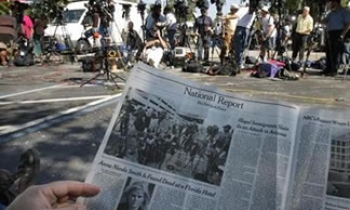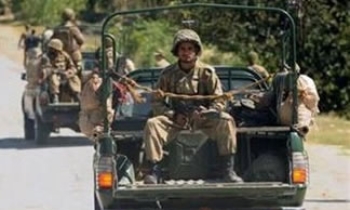In some ways, as 2006 began it held out the promise of huge change, led by the changing of the guard at CBS with Katie Couric's long-anticipated rise to anchor of CBS's evening news show. Many thought Couric would pull the newscast out of the basement and raise it to No. 1.
It didn't happen. CBS finished the year still at No. 3, though better off than before Couric took over.
Yet among media buyers, it remains the defining news story of 2006, along with the changes at "Today" and "The View" that were part of the larger changes in network morning and evening news, including the move of Charles Gibson to anchor ABC's evening news show.
In a Media Life survey over the holiday break, media planners and buyers chose the musical chairs at “CBS Evening News,” “The View” and “Today” as the defining news story of 2006, with some 32 percent of the vote.
Next came the continued rise of internet spending, at 26.7 percent, followed by the record political ad spending, at 12.8 percent, and at No. 4, at 11.8 percent, Nielsen’s new data streams, including digital video recorders.
Readers were less engaged by declines in automotive ad spending, at 6.4 percent, and newspaper personnel cuts, at 4.8 percent.
The voting wasn't nearly as close when it came to the big media debacle of 2006: the aborted O.J. Simpson interview on Fox won easily at 68.4 percent of respondents.
At a distant second was Nielsen’s delayed introduction of commercial minute ratings, with just 14.7 percent of the vote.
Other non-starters were NBC’s poor Winter Olympics ratings, the New York Post's Page $ix gossip bribery scandal, and the sinking of ABC's “Commander in Chief.”
When it came to media events that most put a damper on 2006, the demise of the WB and UPN with their merger into the CW topped the list among media planners and buyers, with the new network retaining around half of their combined audiences.
Nearly 37 percent chose that as the 2006 media casualty that hit the hardest.
Next came NBC's decision to end scripted series at 8 p.m., at 23.7 percent, while Tom Freston’s exit at Viacom came in at No.3 at 10.5 percent.
The series finale of “The West Wing” and the folding of Teen People and Elle Girl tied at 8.9 percent. Bob Schieffer's stepping down from “CBS Evening News" got the fewest votes, at 7.9 percent.
ABC easily won as the network with the best year at 53.5 percent, while NBC was a distant second at 18.9 percent. CBS got 14.6 percent while Fox came in at 13 percent.
The breakout show for 2006 was ABC's “Grey’s Anatomy” at 36 percent, just ahead of ABC's other top show, "Dancing with the Stars,” at 30.2 percent.
No other show came close, in the minds of media buyers. Fox's top-rated "American Idol" earned a weak 9 percent of the vote. TNT's "The Closer” earned just 6.3 percent of the vote, while ESPN's "Monday Night Football” garnered just 2.6 percent.
Among the year's magazine closings, it appears the biggest shocker was the most recent to fold, eMap's lad title FHM, and this despite plenty of evidence that it was fading, most notably a dip in ad pages. Nearly half the poll respondents, 47.5 percent, chose FHM.
Teen People was next at 32.6 percent. Elle Girl, Budget Living and Cargo all earned single-digit votes, 6.6 percent, 7.2 percent and 3.9 percent.
Media Life also wanted to learn what big things to look out for in 2007. Readers responded with a slew of insights and predictions.
Leading the list for television, they predict the quiet disappearance of News Corp.'s MyNetworkTV, which launched earlier this year and quickly went into sputter mode. That got 43.8 percent of the vote.
At No. 2, with 33 percent, was the prediction that NBC will come back even stronger next fall, and not far behind, at 28.1 percent, is that more high-profile sporting events will move to cable from broadcast, following a long trend.
The No. 3 prediction, at 27.6 percent: a shakeup at Fox over its struggles to introduce creative new shows this fall. At No. 4, at 22.7 percent, readers predict that ABC will win the season next spring by a nose.
In newspapers, readers see the big thing as yet more emphasis on merging online and print editions. That was their top prediction at 60.5 percent. Not far behind was more circulation slides, at 54.6 percent.
The big trend in magazines will be a rash of titles folding, readers tell Media Life, and by a wide margin.
Media Life asked readers: What will be the things to watch for in magazines in 2007? Pick one or more.
Tops, at 49.7 percent, was: "A new round of titles folding their print editions to go online only." But just behind, at 44.7 percent, was "A new round of titles folding."
No. 3, at 32.4 percent, was: "A thinning out of the newsstand celeb titles." And 21 percent of respondents chose "The folding of another lads title."
One optimistic note: While few readers see much in the way of new titles launching per se, they do anticipate a run of print titles being spun off from existing web properties. Some 21 percent of respondents chose that as a trend to keep an eye on.
Asked to tell Media Life what they saw as the key issues in 2007, opinions varied widely, but a theme was making do with less.
The question: What do you foresee as the big media issues in 2007?
"Figuring out ways to actually provide real ‘news’ in spite of major budget cuts at nearly all major news organizations," wrote one. "News organizations face a harsh reality that bloggers and the internet will completely own ‘news’ as people want it.”
Another wrote of client spending shifts. "As newer electronic channels gain traction, how our models of ad & content will have to change/shift (think iPods, smart phones, greater access to wireless online access).”
Another issue is the increasing amount of data media people are faced with, both as a blessing and a curse.
Another respondent posed the issue as a question: “What to do with all the data? With media research departments downsized at most companies and third party processors still not the answer, who and/or what will interpret the massive data streams from live vs. live plus DVR viewing vs live plus 7 day DVR viewing vs. minute-by-minute ratings? Add to that the already existing cable ratings vs. DMA ratings vs. ADS/satellite ratings and the media landscape becomes even more murky.”
And of course the internet taking up an ever-larger share of people's time is one of media buyers' concerns, as another writes. "The biggest media issues I see in 2007 are the continued rise of the internet over traditional media such as newspapers and magazines and continued spending on Internet advertising. And as yet another writes, “I believe the internet and determining ROI will continue to be an issue in the next year.”
Diego Vasquez is a staff writer for Media Life.









